Amputation Information: Managing Pain, Healing, and Adjusting to Life Changes
Amputation is the surgical removal of all or part of a limb or extremity such as an arm, leg, foot, hand, toe, or finger. It is typically done to remove damaged or diseased tissue that cannot be saved or to prevent the spread of an infection or disease to other parts of the body. It may also be necessary in cases of severe injury, such as a traumatic accident, in which the affected limb is severely damaged and cannot be repaired. Amputation can be a traumatic and life-changing event for the person undergoing the procedure and can result in physical and emotional challenges, such as phantom limb pain, difficulty with mobility and activities of daily living, depression, and anxiety. Rehabilitation and support from healthcare professionals, family, and friends are critical to help the person adjust and cope with the changes. We will discuss the following topics:
Causes of amputations
Types of amputations
Benefits of amputations
Risks of amputations
Reasons why amputations are performed
Preparation for amputation
Procedure for amputation
Complications of amputations
Prevention of amputations
Management of amputations
Osseointegration
Rotationplasty
Aftercare for amputations
When to seek urgent medical care
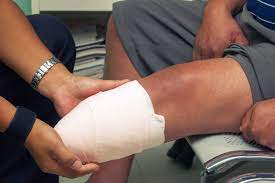
Reasons why amputations are performed
They are performed for a variety of reasons, including:
- Trauma: Amputations may be necessary following a traumatic injury, such as a car accident or industrial accident, where a limb is severely damaged and cannot be repaired.
- Cancer: In some cases, amputation may be necessary to remove cancerous tumors that cannot be treated with other methods, such as chemotherapy or radiation.
- Severe infections, such as gangrene, may require amputation to prevent the spread of infection to other parts of the body.
- Peripheral vascular disease can cause restricted blood flow to the limbs, leading to tissue damage that may require amputation.
- Neuromuscular disorders: Certain neuromuscular disorders, such as peripheral neuropathy or muscular dystrophy, can cause tissue damage and ultimately require amputation. Over time, high blood sugar levels can cause damage to blood vessels and nerves, particularly in the feet and legs. This damage can lead to a condition called peripheral neuropathy, which causes a loss of sensation in the feet and legs. Peripheral neuropathy can make it difficult for people with diabetes to detect foot injuries or infections. If left untreated, even minor injuries can progress to serious infections, which can ultimately lead to tissue damage and the need for amputation.
- Chronic wounds such as pressure ulcers, may require amputation if they are not healing properly or if they become infected.
- Poor circulation in the limbs can cause tissue damage, infections, and other complications that may require amputation. Diabetes, peripheral arterial disease, and blood clots are some examples of circulatory problems that can lead to amputations.
- Congenital defects: In some cases, individuals may be born with a limb that is missing or malformed, and amputation may be recommended as part of a treatment plan.
- Frostbite: Exposure to extreme cold can cause tissue damage that may require amputation.
Types of amputations
There are several types of amputations, and the type of amputation performed will depend on the location and severity of the injury or condition that requires the amputation. The specific type of amputation performed will depend on the individual circumstances and the goals of the treatment plan, such as maximizing function and mobility. Here are some common types of amputations:
Lower limb amputations:
- Partial foot amputation: Removal of a part of the foot, often the toes or forefoot, while preserving as much of the foot as possible.
- Amputation of the lower limb distal to the ankle joint: Removal of the foot and ankle, leaving the remainder of the lower leg intact.
- Ankle disarticulation: Amputation through the ankle joint.
- Amputation of the lower limb at the ankle joint: Removal of the foot and ankle, as well as a portion of the lower leg, below the knee joint.
- Trans-tibial amputation: Amputation below the knee joint, but above the calf muscle.
- Amputation of the lower limb between the knee joint and the ankle joint (below-knee amputation): Removal of the lower leg below the knee joint.
- Knee disarticulation: Amputation through the knee joint.
- Amputation of the lower limb at the knee joint: Removal of the lower leg and knee joint.
- Trans-femoral amputation: Amputation above the knee joint, but below the hip joint.
- Amputation of the lower limb between the hip joint and the knee joint (above-knee amputation): Removal of the entire leg above the knee joint.
- Hip disarticulation: This involves the removal of the entire leg and hip joint.
- Trans-pelvic disarticulation (hemipelvectomy or hindquarter amputation): Removal of the entire lower limb, along with a portion of the pelvis.
Upper limb amputations:
- Partial hand amputation: Removal of one or more fingers or parts of the hand.
- Wrist disarticulation: Amputation through the wrist joint.
- Trans-radial amputation (below-elbow or forearm amputation): This involves the removal of the arm below the elbow but leaving the elbow joint intact.
- Elbow disarticulation: Amputation through the elbow joint.
- Trans-humeral amputation (above-elbow amputation): Removal of the arm above the elbow joint.
- Shoulder disarticulation: Amputation through the shoulder joint.
- Forequarter amputation: Removal of the entire arm, along with the shoulder blade and collarbone.
Other types of amputations:
- Amputation of the ears: Partial or total removal of one or both ears.
- Amputation of the nose (rhinotomy): Partial or total removal of the nose.
- Amputation of the tongue (glossectomy): Partial or total removal of the tongue.
- Amputation of the eyes (enucleation): Removal of one or both eyes.
- Amputation of the teeth (dental avulsion): Removal of one or more teeth.
- Amputation of the breasts (mastectomy): Removal of one or both breasts.
- Amputation of the testicles (castration): Removal of one or both testicles.
- Amputation of the penis (penectomy): Partial or total removal of the penis.
- Amputation of the foreskin (circumcision): Removal of the foreskin covering the head of the penis.
- Amputation of the clitoris (clitoridectomy): Partial or total removal of the clitoris.
- Hemicorporectomy or amputation at the waist: Removal of the entire lower body, including the legs, pelvis, and abdominal organs.
- Decapitation or amputation at the neck: Removal of the head from the body.
- Self-amputation: The act of intentionally cutting or mutilating one’s own body part, often with the aim of seeking relief from a psychological or emotional condition. This behavior is considered a form of self-harm, caused by a variety of factors, including mental illness, severe emotional distress, or extreme drug use and can lead to serious physical and psychological harm.
- Congenital amputation: the absence or partial absence of a limb or limbs at birth. This can occur as a result of a genetic disorder or developmental abnormality during fetal development. Congenital amputation can affect any part of the body, including the arms, legs, hands, feet, fingers, and toes.
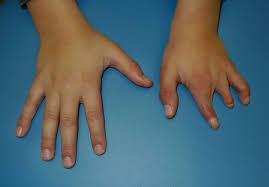
Congenital amputation can be classified into two main categories:
- Terminal transverse deficiencies: This type of congenital amputation involves the complete absence of a limb or a portion of a limb, usually at the end of the limb (terminal). This type of amputation can affect one or more limbs and can range from mild to severe.
- Longitudinal deficiencies: This type of congenital amputation involves the absence of a portion of a limb along its length (longitudinal). This can include missing bones, joints, or segments of the limb.
Benefits of amputations
While amputation is often seen as a last resort, there are some potential benefits to the procedure in certain situations. Some of these benefits include:
- Improved quality of life: In cases where an injury or disease has severely damaged a limb, amputation can relieve pain and improve quality of life by allowing the person to use a prosthetic limb.
- Reduced risk of complications: In some cases, amputation may be necessary to prevent further complications, such as infection or tissue death, which could lead to more serious health problems.
- Improved mobility: Depending on the location and severity of the amputation, a prosthetic limb can allow the person to regain mobility and perform everyday tasks.
- Better psychological well-being: For some people, amputation can provide relief from the physical and emotional burden of a severely damaged limb, improving their overall mental health and well-being.
- Lifesaving: In some cases, amputation may be necessary to save a person’s life, such as in cases of severe trauma or advanced cancer.
It is important to note that the decision to amputate a limb is not taken lightly and is only considered when all other treatment options have been exhausted. The potential benefits of amputation must always be weighed against the risks and potential complications.
Risks of amputations
While amputation can be a life-saving procedure in certain situations, it also carries significant risks and potential complications. Some of these risks include:
- The risk of infection is high after an amputation, particularly during the first few days or weeks when the wound is healing.
- Bleeding is a common risk during and after the amputation procedure, particularly in patients with bleeding disorders or who are taking blood-thinning medications.
- Many people who have had an amputation experience phantom limb pain, which is a sensation of pain, tingling, or itching in the missing limb.
- Pain can also occur at the site of the amputation, particularly if the stump is not well-healed or if the prosthetic limb does not fit properly.
- Contractures occur when the muscles and tendons around the amputation site shorten and become stiff, limiting range of motion and causing discomfort.
- Amputation can have significant psychological effects, such as depression, anxiety, and grief, particularly if the limb loss was sudden or traumatic.
- Prosthetic-related complications such as skin irritation, pressure sores, and poor fit, which can impact mobility and quality of life.
Complications of amputations
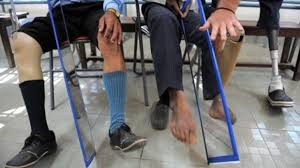
Amputation is a major surgery, and, like any other surgery, it carries some risks and potential complications. Some of the common complications of amputations include:
- The risk of infection is higher after an amputation, especially if the wound is not properly cared for.
- Phantom pain is the sensation of pain, discomfort, or other sensations in the amputated limb, even though it is no longer present.
- Phantom limb sensation is a feeling that the missing limb is still present. This can vary in intensity and frequency, and may include feelings of warmth, cold, itching, tingling, or pressure. For some people, phantom limb sensations can be severe and debilitating. The exact cause of phantom limb sensations is not fully understood, but it is believed to be related to the way the brain and nervous system adapt to the loss of the limb. When the limb is amputated, the nerve endings at the amputation site continue to send signals to the brain, which can result in the sensation of the missing limb.
- Neuroma is a bundle of nerve fibers that can form at the end of the amputated limb, causing pain, tingling, or a burning sensation.
- Contracture is a tightening of the muscles, tendons, and skin around the amputation site, which can make it difficult to fit a prosthetic limb.
- Hematoma is a collection of blood that forms at the amputation site.
- Delayed wound healing: The wound may take longer to heal in some cases.
- Joint stiffness: The joints around the amputation site can become stiff and difficult to move.
- Psychological effects: Amputation can be a traumatic experience, and many people experience emotional and psychological effects as a result.
Prevention of amputations
Here are some general tips that can help prevent amputations:
- Manage underlying health conditions: If you have conditions such as diabetes or peripheral artery disease, it’s important to manage them properly to prevent complications that can lead to amputation. Follow your healthcare provider’s recommendations for managing your condition, such as taking medications, monitoring your blood sugar levels, and making lifestyle changes.
- Take care of your feet: Foot problems such as blisters, calluses, or infections can lead to more serious foot problems, and even amputation in severe cases. Check your feet daily for any changes or abnormalities and seek medical attention if you notice any problems. Wear comfortable, well-fitting shoes and socks, and avoid going barefoot.
- Quit smoking: Smoking can increase the risk of vascular problems that can lead to amputation. Quitting smoking can help improve blood flow and reduce the risk of complications.
- Regular exercise can help improve circulation and prevent complications such as peripheral artery disease. Talk to your healthcare provider about an exercise plan that is appropriate for you.
- Proper hygiene can help prevent infections that can lead to amputation. Wash your hands frequently and keep any cuts or wounds clean and covered until they heal.
-
Seek prompt medical attention: If you experience any signs or symptoms of a potential foot or limb problem, such as pain, numbness, tingling, or a change in skin color or temperature, seek medical attention promptly. Early intervention can often prevent more serious complications.
There are several strategies for managing pain after an amputation, including:
- Pain medication, such as opioids or nonsteroidal anti-inflammatory drugs (NSAIDs), may be prescribed to manage pain after an amputation. It’s important to take medication as directed by your healthcare provider to avoid side effects or addiction.
- Physical therapy can help improve strength and range of motion in the remaining limb, which may reduce pain. It can also help you learn how to use assistive devices, such as crutches or a prosthetic limb, which can help reduce pain.
- Psychological interventions such as cognitive behavioral therapy or relaxation techniques, may help manage pain and improve overall well-being.
- Prosthetic limb can help improve mobility and reduce pain, especially if the amputation was below the knee or elbow.
- Nerve blocks are injections of medication that can block pain signals from the nerves. This may be an option for people who have severe phantom limb pain or stump pain.
Management of amputations

The management of amputations typically involves several components, including preoperative evaluation and preparation, surgical management, and postoperative care. Here are some key aspects of each component:
Preparation for amputation typically involves a team approach that includes the patient, family members, and healthcare providers. The following are some key considerations for preparing for an amputation:
- Evaluation: The patient will undergo a comprehensive evaluation to determine the extent of the limb damage or disease, assess overall health status, and determine the most appropriate type of amputation. A comprehensive evaluation by a healthcare provider to determine the cause and extent of the amputation, and to assess the patient’s overall health status and medical history.
- Education: The patient will receive education on what to expect before, during, and after the amputation, as well as information on pain management, wound care, and rehabilitation. Counseling and education for the patient and their family about the procedure, potential risks and complications, and postoperative care.
- Emotional support: Amputation can be a difficult and emotional experience, and patients and their families may benefit from counseling or support groups to help cope with the emotional and psychological impact of the procedure.
- Pre-operative preparation: Prior to the amputation, the patient may need to take certain medications or undergo additional medical tests. The healthcare team will also prepare the patient for the surgery, including fasting instructions and guidelines on how to care for the affected limb. Preparation of the patient for surgery, which may include discontinuing certain medications, fasting, and other preoperative instructions
- Post-operative care: After the amputation, the patient will need to undergo wound care and rehabilitation to help restore mobility and function. This may involve physical therapy, occupational therapy, and prosthetic limb fitting and training.
- Home preparation: Depending on the extent of the amputation, the patient may need to make modifications to their home to accommodate their new mobility needs, such as installing ramps or handrails.
Surgical management

- The amputation procedure itself, which may be performed under general or regional anesthesia depending on the patient’s condition and the extent of the amputation
- Careful attention to minimizing bleeding and trauma to the residual limb during the procedure
- Reconstruction of the residual limb to facilitate prosthetic fitting and maximize functional outcomes
- Use of advanced surgical techniques, such as targeted muscle reinnervation or osseointegration, to improve outcomes and reduce the risk of complications
Procedure for amputation
The specific procedure for amputation may vary depending on the location and extent of the amputation, but generally involves the following steps:
- The patient is given anesthesia to prevent pain and discomfort during the procedure.
- The surgeon makes an incision in the skin and tissues to expose the underlying bone and blood vessels.
- The surgeon dislocates the joint and divides the bone using a saw or other cutting instrument. In some cases, a special saw may be used to minimize tissue damage and promote healing.
- Hemostasis: The surgeon takes steps to stop any bleeding from the blood vessels and tissues.
- Soft tissue closure: The surgeon closes the incision using sutures or staples and may place a drain to remove excess fluid.
- A sterile dressing is applied to the wound to help promote healing and prevent infection.
- Post-operative care: The patient is closely monitored after the procedure to ensure proper healing and manage any pain or discomfort. The healthcare team may also provide instructions on wound care, medication management, and rehabilitation.
In cases where a prosthetic limb is to be fitted, the residual limb will be shaped and prepared to ensure a proper fit. Prosthetic fitting may occur either before or after the incision has healed, depending on the specific case and the preference of the healthcare team.
Osseointegration
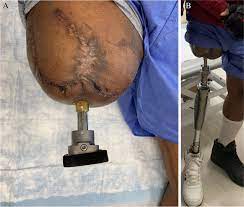
Osseointegration is a surgical procedure that involves implanting a metal rod into the bone to provide a stable anchoring point for a prosthetic limb. The metal rod, also known as a fixture or implant, is typically made of titanium and is surgically implanted into the bone using a process called direct bone anchoring.
During the osseointegration procedure, the metal rod is inserted into the bone and allowed to fuse with the bone over a period of several months. This fusion occurs as the bone grows around the implant and integrates with the surface of the metal.
Once the osseointegration process is complete, a prosthetic limb can be attached directly to the metal rod, providing a more stable and functional connection than traditional socket-based prosthetics. This can improve the comfort, mobility, and function of the prosthetic limb, allowing individuals with limb loss to perform a wider range of activities and tasks.
Rotationplasty
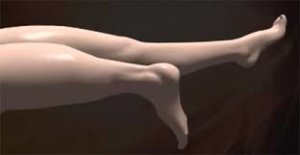
Rotationplasty is a surgical procedure used to treat certain types of lower limb bone cancers, as well as other conditions that require amputation of the lower limb. The procedure involves removing a portion of the affected bone and reattaching the remaining healthy bone in a rotated position, so that the ankle joint becomes the knee joint.
During the rotationplasty procedure, the surgeon removes the affected portion of the bone, along with any surrounding soft tissue and tumors. The remaining healthy bone is then rotated and reattached, so that the ankle joint is positioned where the knee joint used to be. The lower leg is then attached to the upper leg, with the foot and ankle functioning as the new knee joint.
After the procedure, a prosthetic leg is typically attached to the foot and ankle to provide support and mobility. The advantage of rotationplasty is that it allows for better functionality and mobility than traditional above-knee amputations. The ankle joint can provide a more stable platform for walking, running, and other activities, and the range of motion is similar to that of a normal knee joint.
Postoperative care:
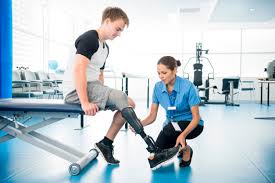
After an amputation, proper aftercare is crucial for healing and adapting to life with a limb loss. Here are some general guidelines for aftercare:
- Pain management, which may involve a combination of medications, physical therapy, and other interventions
- Prosthetic fitting and training to help the patient adjust to and use their new limb
- Counseling and support to address emotional and psychological issues related to the amputation, such as grief, anxiety, and depression
- Your healthcare provider will provide specific instructions for caring for your wound and managing your pain. It’s important to follow these instructions carefully to ensure proper healing.
- Attend physical therapy: Physical therapy is an important part of rehabilitation after an amputation. A physical therapist can help you learn how to use any assistive devices you may need, such as crutches or a prosthetic limb, and can help you rebuild strength and range of motion in the remaining limb.
- Monitor for signs of bleeding, infection, or other complications: It’s important to keep the wound clean and dry to prevent infection. Monitor the wound for signs of infection, such as redness, swelling, or drainage, and report any concerns to your healthcare provider.
- Practice good skin care: Skin care is important for preventing skin breakdown and pressure sores, especially if you use a prosthetic limb. Check the skin regularly for any signs of irritation or redness, and keep the skin clean and moisturized.
- Manage phantom limb pain: Talk to your healthcare provider about strategies for managing this pain, such as medication, massage, or biofeedback.
- Address emotional and psychological needs: Adjusting to life with a limb loss can be challenging emotionally and psychologically. Consider seeking support from a mental health professional or support group to help you cope with the changes and challenges.
- Exercising after an amputation is important for promoting overall health and well-being, as well as helping to prevent complications such as blood clots, pressure sores, and joint stiffness. The type and intensity of exercise recommended will depend on the individual’s specific circumstances, including the level of amputation, overall health, and any other medical conditions. The therapist may recommend a range of exercises, such as stretching, resistance training, and balance exercises.
- Caring for the residual limb: the part of the limb that remains after an amputation. Here are some tips:
- Keep the residual limb clean and dry
- Watch for signs of infection, such as redness, swelling, or drainage, and report any concerns to your healthcare provider.
- Protect the residual limb from bumps or pressure, especially if you are wearing a prosthetic limb. Use a protective cover or padding to help prevent skin breakdown or pressure sores.
- Exercise can help improve strength and range of motion in the residual limb. Work with a physical therapist to develop an exercise plan that is appropriate for you.
- Pain in the residual limb, such as stump pain or phantom limb pain, is common after an amputation. Talk to your healthcare provider about strategies for managing pain.
- A prosthetic limb can help improve mobility and quality of life for many people who have undergone an amputation. Work with your healthcare provider to determine if a prosthetic limb is appropriate for you and what type of prosthetic limb may be best for your needs.
When to seek urgent medical care
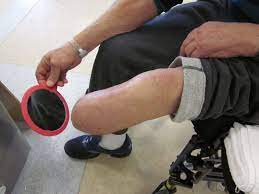
If you have undergone an amputation, it is important to be aware of the signs and symptoms that may indicate a medical emergency. Here are some situations in which you should seek urgent medical care:
- Excessive bleeding: If you experience heavy bleeding from the amputation site, apply pressure to the wound and seek emergency medical attention immediately.
- Signs of infection: If you notice redness, swelling, warmth, or drainage from the amputation site, or if you develop a fever or chills, contact your healthcare provider right away. These may be signs of an infection, which requires prompt treatment to prevent complications.
- Changes in sensation or color: If you notice changes in the color or temperature of your residual limb, or if you experience new or worsening phantom limb pain, contact your healthcare provider for evaluation.
- Difficulty breathing or chest pain: If you experience chest pain, shortness of breath, or difficulty breathing, seek emergency medical care immediately. These may be signs of a serious medical condition, such as a blood clot or heart attack.
- Severe pain: If you experience severe or uncontrolled pain, despite taking pain medications as prescribed, contact your healthcare provider for further evaluation and management.
If you are unsure whether your symptoms require urgent medical attention, it is always best to err on the side of caution and seek medical advice. It is important to work closely with your healthcare provider to develop a plan for managing any potential complications after an amputation.
Disclaimer: The information provided in this content is for general informational purposes only. It is not intended as medical or healthcare advice, diagnosis, or treatment. Always seek the advice of a qualified healthcare professional with any questions you may have regarding a medical condition or healthcare decisions.

